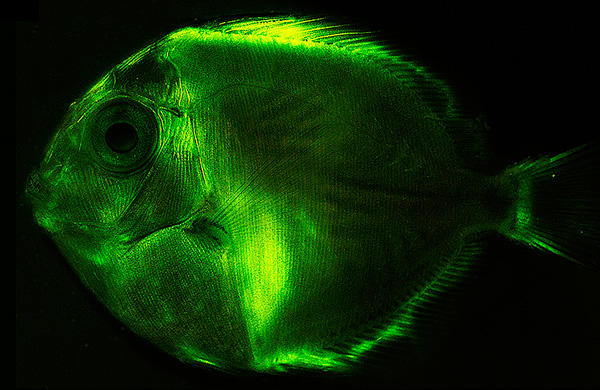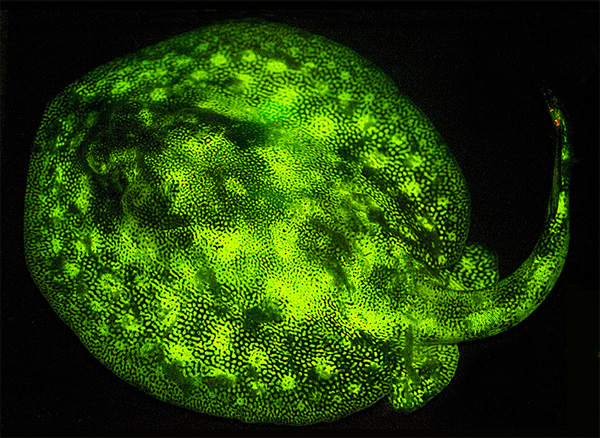Biofluorescence is widespread among marine fish species, indicating its importance in communication and avoiding detection, finds a new study published in the journal PLOS ONE.
The research shows that biofluorescence — a phenomenon where organisms absorb light, transform it, and emit it as a different color — is more common in the animal kingdom than previously known. Conducting aquarium-based experiments and a series of reef dives using high-intensity blue lighting, the researchers led by scientists from the American Museum of Natural History identified more than 180 species of biofluorescent fishes across 50 fish families.
"By designing scientific lighting that mimics the ocean’s light along with cameras that can capture the animals’ fluorescent light, we can now catch a glimpse of this hidden biofluorescent universe," said co-lead author David Gruber, an associate professor of biology at Baruch College and a research associate at the American Museum of Natural History (AMHN), in a statement. "Many shallow reef inhabitants and fish have the capabilities to detect fluorescent light and may be using biofluorescence in similar fashions to how animals use bioluminescence, such as to find mates and to camouflage."

Glowing surgeonfish (Acanthurus coeruleus, larval). © PLOS ONE.

False moray eel (Kaupichthys brachychirus); I). Chlopsidae (Kaupichthys nuchalis); J). pipefish (Corythoichthys haematopterus).
Biofluorescence is useful to fish that live in a world where visible light is rapidly absorbed the deeper they live, seemingly leaving everything a hue of blue. But biofluorescent fish make the best of the conditions, absorbing blue light and re-emitting it in neon red, orange, and green patterns, opening up a world that is invisible to the human eye. The biofluorescence emitted by fish closely matches that emitted by other organisms that share their habitat, including corals.
“We’ve long known about biofluorescence underwater in organisms like corals, jellyfish, and even in land animals like butterflies and parrots, but fish biofluorescence has been reported in only a few research publications,” said co-lead author John Sparks, an ichthyologist at AMHN. “This paper is the first to look at the wide distribution of biofluorescence across fishes, and it opens up a number of new research areas.”
The biofluorescent proteins in fish could eventually be used for biomedical research and other applications, according to the authors.
Biofluorescent Fish Pictures

Images of reef fishes fluorescing in their natural habitat captured with a Red Epic video camera at night in the Solomon Islands. (A) A red fluorescing scorpionfish, Scorpaenopsis papuensis, perched on red fluorescing algae. (B) A green fluorescing nemipterid (bream), Scolopsis bilineata, near a green fluorescing Acropora sp. coralhead.
 Biofluorescent frogfish (Antennarius maculatus)
Biofluorescent frogfish (Antennarius maculatus)

Biofluorescent stonefish (Synanceia verrucosa)

Biofluorescent ray (Urobatis jamaicensis)

A). swell shark (Cephaloscyllium ventriosum); B). ray (Urobatis jamaicensis); C). sole (Soleichthys heterorhinos); D). flathead (Cociella hutchinsi); E). lizardfish (Saurida gracilis); F). frogfish (Antennarius maculatus); G). stonefish (Synanceia verrucosa); H). false moray eel (Kaupichthys brachychirus); I). Chlopsidae (Kaupichthys nuchalis); J). pipefish (Corythoichthys haematopterus); K). sand stargazer (Gillellus uranidea); L). goby (Eviota sp.); M). Gobiidae (Eviota atriventris); N). surgeonfish (Acanthurus coeruleus, larval); O). threadfin bream (Scolopsis bilineata). © PLOS ONE
CITATION: Sparks JS, Schelly RC, Smith WL, Davis MP, Tchernov D, et al. (2014) The Covert World of Fish Biofluorescence: A Phylogenetically Widespread and Phenotypically Variable Phenomenon. PLoS ONE 9(1): e83259. doi:10.1371/journal.pone.0083259
Source:
http://news.mongabay.com/2014/0110-glowing-fish.html#2OgySxfJAj4VsrgU.99
http://www.sciencerecorder.com/news/glowing-fish-everywhere-study-discovers-widespread-use-of-biofluorescence-photos/
The research shows that biofluorescence — a phenomenon where organisms absorb light, transform it, and emit it as a different color — is more common in the animal kingdom than previously known. Conducting aquarium-based experiments and a series of reef dives using high-intensity blue lighting, the researchers led by scientists from the American Museum of Natural History identified more than 180 species of biofluorescent fishes across 50 fish families.
"By designing scientific lighting that mimics the ocean’s light along with cameras that can capture the animals’ fluorescent light, we can now catch a glimpse of this hidden biofluorescent universe," said co-lead author David Gruber, an associate professor of biology at Baruch College and a research associate at the American Museum of Natural History (AMHN), in a statement. "Many shallow reef inhabitants and fish have the capabilities to detect fluorescent light and may be using biofluorescence in similar fashions to how animals use bioluminescence, such as to find mates and to camouflage."

Glowing surgeonfish (Acanthurus coeruleus, larval). © PLOS ONE.

False moray eel (Kaupichthys brachychirus); I). Chlopsidae (Kaupichthys nuchalis); J). pipefish (Corythoichthys haematopterus).
Biofluorescence is useful to fish that live in a world where visible light is rapidly absorbed the deeper they live, seemingly leaving everything a hue of blue. But biofluorescent fish make the best of the conditions, absorbing blue light and re-emitting it in neon red, orange, and green patterns, opening up a world that is invisible to the human eye. The biofluorescence emitted by fish closely matches that emitted by other organisms that share their habitat, including corals.
“We’ve long known about biofluorescence underwater in organisms like corals, jellyfish, and even in land animals like butterflies and parrots, but fish biofluorescence has been reported in only a few research publications,” said co-lead author John Sparks, an ichthyologist at AMHN. “This paper is the first to look at the wide distribution of biofluorescence across fishes, and it opens up a number of new research areas.”
The biofluorescent proteins in fish could eventually be used for biomedical research and other applications, according to the authors.
Biofluorescent Fish Pictures

Images of reef fishes fluorescing in their natural habitat captured with a Red Epic video camera at night in the Solomon Islands. (A) A red fluorescing scorpionfish, Scorpaenopsis papuensis, perched on red fluorescing algae. (B) A green fluorescing nemipterid (bream), Scolopsis bilineata, near a green fluorescing Acropora sp. coralhead.
 Biofluorescent frogfish (Antennarius maculatus)
Biofluorescent frogfish (Antennarius maculatus)
Biofluorescent stonefish (Synanceia verrucosa)

Biofluorescent ray (Urobatis jamaicensis)

A). swell shark (Cephaloscyllium ventriosum); B). ray (Urobatis jamaicensis); C). sole (Soleichthys heterorhinos); D). flathead (Cociella hutchinsi); E). lizardfish (Saurida gracilis); F). frogfish (Antennarius maculatus); G). stonefish (Synanceia verrucosa); H). false moray eel (Kaupichthys brachychirus); I). Chlopsidae (Kaupichthys nuchalis); J). pipefish (Corythoichthys haematopterus); K). sand stargazer (Gillellus uranidea); L). goby (Eviota sp.); M). Gobiidae (Eviota atriventris); N). surgeonfish (Acanthurus coeruleus, larval); O). threadfin bream (Scolopsis bilineata). © PLOS ONE
CITATION: Sparks JS, Schelly RC, Smith WL, Davis MP, Tchernov D, et al. (2014) The Covert World of Fish Biofluorescence: A Phylogenetically Widespread and Phenotypically Variable Phenomenon. PLoS ONE 9(1): e83259. doi:10.1371/journal.pone.0083259
Source:
http://news.mongabay.com/2014/0110-glowing-fish.html#2OgySxfJAj4VsrgU.99
http://www.sciencerecorder.com/news/glowing-fish-everywhere-study-discovers-widespread-use-of-biofluorescence-photos/

.jpg)

Post a Comment